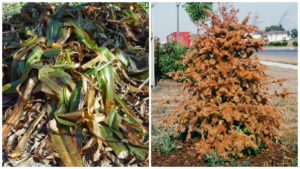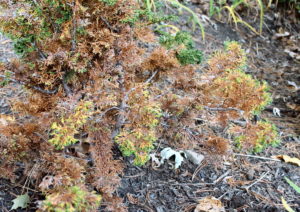Abnormal Is the New Normal
November 10th, 2020
So here we are into the second week of November, and the temperatures are still pushing 70 degrees.

2020 was a year that killed plants from too much cold in May and then killed them from too much heat in July.
Since much of the Harrisburg area just missed that brush with frost the last week of October, the annual flowers and summer vegetables are still chugging along at this historically late point of the season.
It doesn’t surprise me.
I also wouldn’t be surprised if the temperatures suddenly nosedived, threatening cold injury to plants that didn’t have a chance to go through their usual and necessary gradual slide into winter dormancy.
In fact, nothing surprises me with our roller-coaster weather anymore.
If anything, I’m surprised when we get “normal” weather – whatever that is anymore.
It seems that abnormal has become the new normal.
Consistency and modest weather changes are out. Erratic and extreme are in.
Humans can adapt by retreating into the air-conditioning in summer and cranking up the furnace in winter. But plants are stuck out there to roll with the punches and try to survive extremes that their genetics haven’t prepared them for.
About all we can do is give our plants the best conditions possible (good soil, water in droughts, adequate nutrition, etc.) – and then figure on replacing the “wimps” that can’t endure.
Although these changes have been going on for years now, 2020 was a poster child for wacky weather.
Read George’s PennLive column on how the changing climate is affecting gardening
Read George’s PennLive column on 10 ways gardeners can adapt to the changing climate
Harrisburg-area gardeners and plants endured a hot-cold-hot “sandwich” this season, featuring a very warm winter that fast-forwarded plant growth, then a spring chill that gave us our coldest May day ever, then our hottest summer ever.
Temperatures hit 69 degrees on Jan. 11 and 12 on the way to our 10th warmest January on record.
February 2020 was our fifth warmest February on record, and March followed by averaging six degrees above normal, hitting 78 degrees on March 20.
Then the see-saw tilted. April turned out to be colder than usual, bringing those prematurely budding and leafing plants to a screeching halt.
The biggest insult came on May 10. After so many people had planted their summer flowers and vegetables with the impending arrival of Mother’s Day, overnight temperatures dipped to 30 degrees – our lowest May reading ever and cold enough to kill those tender plants.
But by the end of the month, temperatures were up to 87 degrees, followed by an incredible string in which every day between June 18 and Aug. 6 was hotter than the historical average for that day.
July was our hottest month ever with 22 days hitting 90 degrees or higher, and August followed with another 10 days of 90-degrees-and-up (more than four degrees warmer than usual for the month as a whole).
Summer was also very dry much of the time. Remnants of Hurricane Isaiah bailed us out a bit in an otherwise parched July, and a couple of August rains helped head off the drought threats that affected the northern and western parts of the state.
Still, the dry periods combined with the intense heat to cause a fair amount of leaf scorching and even death to new plants that weren’t kept adequately damp.
Hinoki cypress is one plant that’s showing its displeasure more than any I’ve noticed.
It’s normal for these to show some browning of the inner needles as they age. In stressful growing seasons, more browning than usual occurs.
This year, I’ve seen Hinoki cypresses sporting brown needles almost the whole way out to the tips, where this season’s new growth is the only green.
Hopefully, the heat/dry stress won’t be enough to kill plants in that situation. And hopefully, next year’s new growth will quickly fill in some of the bareness. But in the meantime, Hinokis and other evergreens are going to look a bit scraggly.
I learned two lessons from the 2020 season – at least when it comes to weather.
One is that just because we’re warming in general doesn’t mean we can’t get sudden and even record-setting freezes. Keep a close eye on forecasts before planting.
The other is that we may as well get used to extremes. It’s not unusual to get hit with a super-heavy soaking that floods yards and washes away soil followed immediately by the beginning of a “flash drought” that has us married to the hose the rest of the season.
At least we did have a spell in there toward late summer and early fall when the weather gave us just the right conditions for an excellent fall-foliage year.
That was nice. And surprisingly “normal.”









